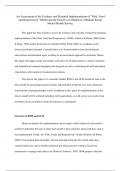An Assessment of the Evidence and Potential Implementation of “Risk, Need
and Responsivity” Model and the Good Lives Model in a Medium Secure
Mental Health Service.
This paper has been written to assess the evidence and critically evaluate the potential
implementation of the ‘Risk, Need and Responsivity’ (RNR; Andrews & Bonta, 2006; Bonta
& Hoge, 1990) and/or the Good Lives Model (GLM; Ward, 2002) in a medium secure
forensic psychiatric hospital. Currently there is no formal model to base psychological
interventions and treatment upon, resulting in an inconsistent approach to treatment. Hence,
this paper will suggest using one model as the basis for all interventions to ensure continuity
and reliability in treatment throughout the hospital, as well as confirming all staff and patient
expectations with regards to treatment interventions.
The aim for this paper is to conclude whether RNR or the GLM should be used as the
basis model for psychological interventions and treatment within the new acute admission
ward and the remaining hospital wards. In addition to this, plans for implementation of the
chosen model will be outlined including staff requirements, as well as how any results from
treatment can be recorded to ensure best practice is maintained.
Overview of RNR and GLM
Before evaluation for implementation can be made, a brief outline of each model is
needed to determine the type of client each model is best suited for, along with how each is
best implemented. Firstly, the “Risk, Needs and Responsivity” model (Andrews & Bonta,
2006) is based upon three principles: the risk principle being the first which states that
criminal behaviour can be reliably predicted, providing need for evidence-based risk
instruments to manage and reduce risk (Bonta & Andrews, 2007). RNR proposes that this
, reduction can occur when the level of treatment is in proportion to the level of risk, whereby
the higher risk offender receives more intensive treatment. The need principle highlights the
importance of criminogenic needs in the creation and implementation of treatment plans.
Criminogenic needs present in the form of two types of risk factors: dynamic and static, with
both having a direct link to offending behaviour. Dynamic risk factors which can be reduced
and removed, while static risk factors are unmoveable by treatment and can only increase or
be maintained. Finally, the responsivity principle explains how the treatment should be
provided. This principle can be split into two sections: general and specific responsivity. The
former incorporating the use of cognitive social learning methods to teach new prosocial
behaviours to replace the offending and the latter to regulate the cognitive behavioural
intervention taking into account individual differences that can affect treatment, such as
learning style (Bonta & Andrews, 2007). Thus, treatment should be tailored to fit each
individual based on their personal strengths and socio-personality factors to maximise
attention and therefore learning.
Research has claimed the RNR model to be successful (Newsome & Cullen, 2017)
with empirical evidence to support this (see: Andrews & Bonta, 2010; Smith, Gendreau &
Swartz, 2009). For example, based on tests of the need principle in RNR, successfully
addressing criminogenic needs during treatment intervention is associated with an average
19% difference in recidivism rates (Bonta & Andrews, 2007). Further to this, if adherence to
the general responsivity principle is examined, such as the use of cognitive behavioural
methods during intervention, there is an average 23% difference in recidivism (Andrews &
Bonta, 2006). In addition to this, Bonta and Andrews (2007) claim that any treatment
intervention that does not adhere to any of the risk, need or responsivity principles and
therefore target non-criminogenic needs using non-cognitive-behavioural techniques, are in
fact criminogenic in themselves. This is a particular concern in residential settings such as




